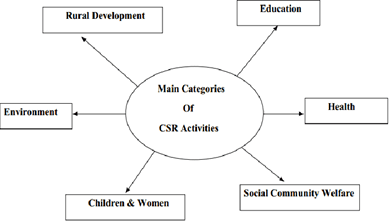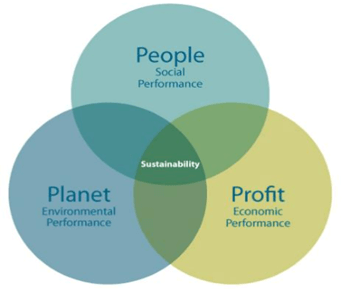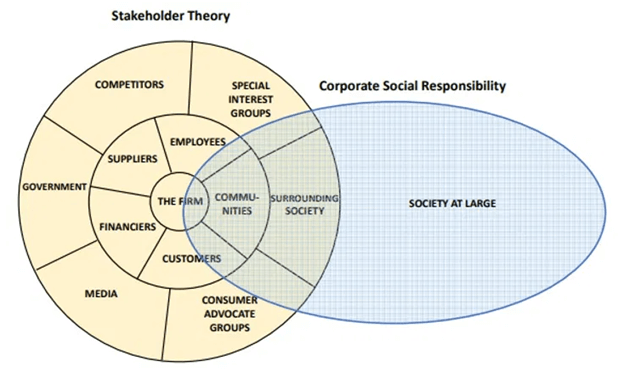Comparative Analysis Of CSR Initiatives In The Public Vs Private Sector
Seeking assignment help online in the UK? Native Assignment Help is here to alleviate your academic burden. With our user-friendly platform and round-the-clock support, getting top-notch assignments has never been easier.
Introduction:Comparative Analysis Of CSR Initiatives In The Public Vs Private Sector
CSR also known as Corporate Social Responsibility makes companies, organisations, and sectors socially, financially, and environmentally liable to their investors, shareholders, to its employees, workers, and majorly to its customer base. CSR is also known as 'corporate citizenship' that devotes to framing a model for sectors and businesses by which it can not only generate revenue but also finds a better way to build a loyal customer base (Vishwanathan et al., 2020). It has been found that CSR has been one of the sole reasons for companies and sectors to achieve or increase customer satisfaction. The business and economy of the modern world revolve around various contemporary factors, and income is not the only prime factor. The consumers of this modern world are more conscious and self-aware, they are financially, socially, and environmentally educated with greater demands. This new customer base has greater expectations from the brands and sectors they are opting from, for instance, the customers might boycott a sector that uses children as its labour source, or companies that do not provide non-plastic packaging contributing heavily to pollution (Ahmad et al., 2021). CSR is essential for the sectors to interpret what exactly are the demands of the customers and guide them as a model to achieve that satisfaction from the customers.
To materialise such customer requirements, sectors whether it is private or public must take up initiatives. The initiatives are the aims and goals promised to achieve by the companies in their fiscal years. For instance, reducing the usage of plastic, minimsing carbon emissions, stoppage of child labour, encouraging recycling, and many more are the initiatives taken by private and public sectors, irrespectively. However, the CSR initiatives taken up by the public and private sectors might be different from each other, as their customer base, investors and shareholders are of different types. Despite the differences, this essay aims to trace the phenomena of CSR initiatives, theories and models related to it, the importance of such initiatives, and ultimately a comparative analysis between the initiatives taken up by both the public and private sectors (Latapí Agudelo, Jóhannsdóttir, and Davídsdóttir, 2019).

Figure 1: CSR or Corporate Social Responsibilty.
Discussion
The economy and business constitute the most integral part of society. Globalisation is modifying the world, and as a result, there emerges quite a lot of sectors and organisations that regulate the economy. There exist public and private sectors of business that operate in similarities and dissimilarities, and regulate the world of business. A public sector is a sector that is essentially owned and operated by a state, and the income of these sectors is deployed for the welfare of the public (Alford, and Greve, 2017). Whereas the private sector can be defined as something which is the total opposite of the previous one. The public sectors are owned privately by a conglomerate of owners, or might have single ownership, and are not controlled by any states. The income is generally acknowledged by the private owners alone. Both sectors have their characteristic features and both sectors have deployed the usage of CSR to achieve their own respective goals. CSR or corporate social responsibility has been described earlier and it is surely different in both the public and the private sectors. However, it is unlikely that they aimed for different results other than generating customer satisfaction which will indirectly increase the sector's revenue generation. The importance of the role of CSR lies in its contribution to make the sectors, public and private liable or answerable to society, and to take up a certain amount of initiatives that will benefit society as a whole (Barnett, Henriques, and Husted, 2020).
CSR initiatives might be of different natures in the public and private sectors and this essay focuses mainly on the comparative analysis of the two. CSR initiatives are taken up in both sectors, however, it is widely perceived that as the private sectors or organisations are profit-oriented then they invest less in CSR activities. Studies, however, show a different picture, in which eighty-two percent of the public sector invests in CSR initiatives, whereas only sixty-six percent is invested by the public sector in the same. However, the issues of women empowerment, stoppage of child labour, legal working hours, community well-being, development of the rural and poor, spread of education, and many more are addressed by both (Belyaeva et al., 2020). The comparative analysis of both sectors in the context of CSR thus can be done with evidence and examples. For instance, CSR initiatives are varied and scattered ranging from different issues in the private sector, whereas in the public sector the initiatives are more or less similar issues. It is seen that both sectors are taking up initiatives in the matter of health as a factor. The public and the private sectors are contributing to the spread of health programs, medical camps, health insurance, and health facilities for their employees or even customers, and also by spreading awareness about some raging diseases like HIV/AIDS, and cancer and encouraging the vaccination process. Through health, both sectors took initiatives for providing relief to the poor, rural, and underprivileged women and children of the society.

Figure 2: CSR Activities.
Education is another factor to which public and private sectors are contributing, with almost twenty percent investment to open schools and provide facilities to the children by the public sectors. Private companies, at the same time, invest heavily in this philanthropic approach and also donate almost a similar percentage to the public sector. For instance, the TATA, a private sector, donates heavily to the cause of education in India and also supports non-discriminated children's education by fighting against the raging issue of child labour. Both public and private companies take up the issue of environmental deterioration seriously and are acting actively and collectively to cut out carbon emissions, the lesser use of plastic in packaging, and increase the practice of sustainable packaging (Mulgan, 2000.). The pledge taken up collectively by public companies is known as the 'net zero' pledge, and it is an initiative to cut all possible ways to reduce environmental pollution that is resulting from the production process. An initiative by Amazon, a private sector, called the Climate Pledge also takes up similar pro-environmental initiatives.
However, the revenue that is generated by both sectors, is not equally invested in the CSR initiatives or their sustainability concerns. But there are almost no dissimilarities in the reporting practices of CSR and sustainability initiatives in these sectors. Not only is there an imbalance in investment in the companies within the sectors themselves, but also companies who are not directly connected with the issue of environment or education, refuse to invest in the problems. Sustainability concerns are also quite similar to CSR activities, including issues of the underprivileged, the environment, and society. The private sector is more invested in the achievement of sustainability concerns rather than the public sector. However, both issues are interrelated, and that makes both sectors liable to society, especially to its customer base to start initiatives to address the concerns (Lu et al., 2019). The world of business has surely modified itself to achieve such outcomes that will be aligned with the concerns. Business activities have thus changed over the decades, for instance, reduction of overproduction, reduction in plastic waste production, and reduction in packaging waste production and through these many of the sustainability, concerns were achieved.
There are numerous theories and frameworks to implement and materialise CSR activities by companies in society. One such theoretical framework is known as the Triple Bottom Line theory, which speaks of the concept in which CSR is applied and in which there are three basic elements, ly the people, planet, and prosperity. Prosperity is interchangeably known as profits, and the theoretical framework is also known as the theory of 3P's (Agrawal, and Singh, 2019). This theory has its focuses mainly on the upliftment of the factors like society, environment, and finance. This theory encapsulates and weighs the rate of success a sector is having in the above three fields. The theory asks questions by which it is understood, how a sector is contributing environmentally, socially, and economically? The success rate is thus measured by these questions in the context of the 3P's. The theory just doesn't focus on the financial or the economic aspect of the business whereas, it focuses on the social and environmental issues, or rather the sustainability concerns. It is known that the triple bottom line theory contributes heavily to the understanding of the performances of the companies and benefits from its hard work of increasing customer satisfaction and customer loyalty (Varyash et al., 2020). This measuring theory makes the management of a company understand the points by which brand value can be increased in the context of 3P's. TBL or the triple bottom line theory is simultaneously used by both the private and the public sectors, however, it has been seen that the theory has been more in practice with private companies.

Figure 3: Triple Bottom Line Theory.
In handling and managing the initiative private and public sector enterprises need to focus on the stakeholders and their interest in the CSR initiative. The stakeholder theory is another theory of CSR that helps enterprises to analyze the interrelationship between the stakeholders and the business (Abdelmotaleb and Saha, 2018). Stakeholders in the private and public sectors include any recognizable group or individual who may impact the accomplishment of an organization's goals or who is affected by the success of those objectives. According to stakeholder theory, a company in the public and private sectors can only succeed in accomplishing its goals if it takes all of its stakeholders' concerns into account. Stakeholder philosophy is a agenda for labelling companies, commercial administration, and the way panels of managements reflect the requirements of various shareholder groups in a particular situation or decision-making process (Hughes et al., 2019). At the same time, the theory is put to practical use by establishing the link between shareholder administration and the CSR approach.

Figure 4: Stakeholder theory of CSR
Without the input, knowledge, and reliability of their many constituents, businesses would fail to reach their CSR objectives. One basic principle of CSR is that businesses must response to the people who matter to them most—those whose interests are directly affected by the firm's actions. The focus of CSR is on the greater good, whereas the goal of stakeholder theory is to strengthen the bonds and increase the value between a company and its many constituents. Supporting the concept of CSR with shareholder philosophy allows front-runners to adopt a more pragmatic approach by taking into account the welfare of all its shareholders and organizing their activities appropriately, therefore reducing the many difficulties inherent in putting such initiatives into reality.

Figure 5: Interrelationship between CSR and Stakeholder theory
The problem of people being unaware of CSR's advantages is addressed by stakeholder theory. If the CSR efforts are in line with stakeholder theory, the organization will reap the most rewards in terms of social progress, employee morale, the company's reputation, the bottom line, and the happiness of the consumers, among other things. So CSR is an aspect of corporate responsibility and needs the help of many different people and groups to be effective (Lee and Yoon, 2018).
The core idea of stakeholder theory is that a business provides a means for individuals to collaborate for the sake of economic gain. Organizations in the private and public sectors succeed in accomplishing sustainability goals when individuals and groups work together to solve problems and better their situations, and that happens when they do it voluntarily. According to stakeholder theory, for a business to succeed, its top executives must determine what common interests and goals unite the company's many constituencies (Tulcanaza-Prieto et al., 2020). Through their interest and goals, they will be able to establish the mission of the company, choose the business strategy they will use, and establish the necessary connections with key constituencies. Management may win over stakeholders to the company's cause by making them feel vested in its success. According to the theory, business leaders should prioritize satisfying all interested parties, not just shareholders. Stakeholders include everyone who has an interest in or is impacted by the corporation's mission (Marx, 2019). The key constituents of every business are its board of directors, management, staff, shareholders, clients, and suppliers. Many businesses have many groups of interested parties, such as local governments, NGOs, communities, and even rival firms.
Organizations in the private and public sectors actively promote staff engagement in the events of corporate social responsibility. Organizations' participation in community service is essential to society as a whole. The employees and staff working for a public organization do not have any qualms with the institution's policy of providing consistent funding for CSR. Contrarily, private enterprises also provide consistent funding for CSR initiatives (Yu et al., 2018). When it comes to CSR and creating wealth, the vast majority of public and private corporation personnel are in agreement. Many companies in different industries today are issuing sustainability reports that detail how their CSR initiatives related to their fundamental values, goods, and services.
Although CSR is a company management strategy that is taken voluntarily, it is heavily influenced by public policy. When the public sector works to create an environment where ethical businesses may flourish, everyone benefits. An empowering atmosphere supports commercial endeavors that limit negative effects on society and the environment while keeping or increasing profits (Rashed and Shah, 2021). Environmental, labor market, public expansion, human moralities, anti-exploitation, and authority reporting are some of the policies of public sectors that may affect corporate social responsibility and the goals of corporations.
Award systems, information hubs, operations, preparation and capability development initiatives, payment transparency, public shaming, and toolkits are all examples of ways in which the public and businesses may be made more aware of the concept of corporate responsibility and its implementation. Collective action, multi-stakeholder collaboration, and public-private partnerships are all examples of partnerships that aim to generate win-win scenarios in which different parties work together to achieve a common objective (Buhmann et al., 2018). Codes of conduct, international principle implementation, standards for CSR reporting, tying CSR components to public procurement processes, and export credit boards are examples of soft law measures that encourage and incentivize voluntary action by businesses in addition to state legislation. Company statutes, pension fund guidelines, stock exchange rules, CSR reporting mandates, and non-compliance fines are all examples of mandates that help governments keep an eye on and punish negligent corporations.
The benefits of CSR on society are still debated as private and public sectors consider distinct ways of handling CSR activities. Closer inspection indicates that shareholder and other stakeholder conflicts are to blame for the gap between public and private firm performance (Moggi et al., 2018). A private company's owners may make choices on how to balance profit with social responsibility. There is a chance they would start a project that would not be profitable but would benefit society. This leeway is almost nonexistent in publicly traded corporations. If a corporate social responsibility (CSR) project or program has positive social outcomes but negative financial outcomes for the company's shareholders, the financial outcomes are more likely to win out.
Following the theories and framework organizations in the private and public sectors need to implement business strategies that are aligned with corporate social responsibility. Managers and leaders should be expected to apply what they learn in assortment and enclosure preparation in smaller groups and one-on-one situations, according to the principles of socially responsible businesses. Topics like physical and emotional health are integral to any healthy workplace culture discussion.
Companies with excellent workplace cultures generate optimistic response loops that contribute to their CSR efforts. When workers are appreciated for their contributions, they are more motivated to achieve their best. Businesses in the private and public sectors with a conscience have objectives they can track. Goals that can be measured help organizations remain responsible to their constituents and the public (Coluccia et al., 2018). Those in charge of CSR make plans with several different factors in mind. Influence in the local community, efficient internal operations, extensive marketing, and positive interactions with the public and government all rank high among these concerns. First and foremost, executives should pay attention to indicators of how well a CSR plan is working. A good example of a program that needs clear and objective standards aims to alter the company's supply chain (Nazir and Islam, 2020). The company must convey the results of its supply chain analysis to both internal and external stakeholders in the form of raw figures, percentage changes, and industry benchmarks.
Timing is crucial in achieving CSR-related business strategies. Leaders in CSR should think about the program's impact both now and in the future. Longer time frames may be necessary for the successful implementation of certain CSR initiatives and activities. The CSR manager and leader are responsible for establishing objectives that are reasonable in light of these time constraints (Lu et al., 2019). Companies in the private sector use an invisible approach as a CSR strategy which is by far the most prevalent. This means that corporations engage in CSR initiatives but do not make a big deal out of publicizing them. This is helpful when the customers' purchasing decisions are unaffected by the CSR efforts but organizations still focus on building trust and credibility with the general public via advertising campaigns.
The success of every organization depends on several interrelated elements, including the ability to attract and retain top personnel, set and achieve growth targets, anticipate potential threats and capitalize on openings, and many more (Brieger et al., 2020). However, if organizations in the public and private sectors need to achieve any of those goals, they will need to institute a system of continuous improvement throughout all of their divisions and in the quality of their service or product. Consistent improvements of products and services allow organizations to achieve a positive image in the society and environment. To best serve their most important stakeholder, consumers, successful brands routinely solicit and use feedback from their patrons. Gathering feedback from the stakeholders allows organizations to identify CSR gaps that need to be rectified and improved (Coluccia et al., 2018). Good judgments may be distinguished from poor ones by their consistency with the overall plan. Leaders should avoid making hasty judgments out of anxiety or panic, especially if they are trying to justify temporary solutions.
Some businesses in the present times have started focusing on reducing their carbon footprint by tracking and controlling their emissions of greenhouse gasses. They want to advance in ways that will benefit their business. Another common method is when a business treats the problem more seriously, initiating some kind of materiality evaluation to determine what exactly is important to them and stakeholders outside the organization. This demonstrates a significant commitment to environmental sustainability (Buhmann et al., 2018). As such, it demonstrates a commitment to incorporating sustainability into all aspects of corporate operations. In developing sustainable business strategies leaders play a vital role. Leaders motivate followers and other stakeholders in private and public sectors to do collective action in pursuit of a common goal. To create a better world, leaders motivate their followers to work together in accomplishing the sustainability of business strategies. When they bring about, facilitate, or encourage transformation, they are typically hailed as agents of change. Leadership plays a critical role in sustainability because it drives the transformation required to achieve the goal.
Setting objectives, testing assumptions, taking chances, and, perhaps unexpectedly, getting the fundamentals right are all essential components of sustainable corporate leadership. Leaders help in setting objectives by aligning with the CSR approaches that the organizations need to accomplish (Hughes et al., 2019). On the other hand, implementing sustainable business strategies results in challenges and risks for the business which are managed by the leaders in a particular organization in the public and private sectors.
Conclusion
The public and private sectors have different ways of handling CSR initiatives and concerns in their respective businesses. It can be concluded that both sectors implement different strategies and measures in aligning business strategies with CSR. Furthermore, the leaders play a vital role in managing and handling the CSR activities in the business. It can be concluded that organizations in both sectors enact different leadership styles in handling and improving CSR for the business. The findings of the essay illustrate that both private and public sectors collaborate in certain circumstances to achieve better CSR goals and objectives. CSR is a management strategy that is influenced by the policies and measures created by the public sector. It has also been found that the Triple Bottom Line theory and Stakeholder theory of CSR are some of the theories that help in acquiring ergonomic gain while providing positive benefits to the society and environment. The findings also specify that the initiatives and concerns of both sectors are different as the types of operational processes and the investors are different in both the public and private sectors. On the other hand, minimizing the use of plastic, encouraging recycling, and mitigating child labor are some of the initiatives that are common in both private and public sectors.
References
Abdelmotaleb, M. and Saha, S.K., 2018. Corporate social responsibility, public service motivation and organizational citizenship behavior in the public sector. International Journal of Public Administration.
Agrawal, S. and Singh, R.K., 2019. Analyzing disposition decisions for sustainable reverse logistics: Triple Bottom Line approach. Resources, Conservation and Recycling, 150, p.104448.
Ahmad, N., Scholz, M., Ullah, Z., Arshad, M.Z., Sabir, R.I. and Khan, W.A., 2021. The nexus of CSR and co-creation: A roadmap towards consumer loyalty. Sustainability, 13(2), p.523.
Alford, J. and Greve, C., 2017. Strategy in the public and private sectors: Similarities, differences and changes. Administrative Sciences, 7(4), p.35.
Barnett, M.L., Henriques, I. and Husted, B.W., 2020. Beyond good intentions: Designing CSR initiatives for greater social impact. Journal of Management, 46(6), pp.937-964.
Belyaeva, Z., Shams, S.R., Santoro, G. and Grandhi, B., 2020. Unpacking stakeholder relationship management in the public and private sectors: the comparative insights. EuroMed Journal of Business, 15(3), pp.269-281.
Brieger, S.A., Anderer, S., Fröhlich, A., Bäro, A. and Meynhardt, T., 2020. Too much of a good thing? On the relationship between CSR and employee work addiction. Journal of Business Ethics, 166(2), pp.311-329.
Buhmann, K., Jonsson, J. and Fisker, M., 2018. Do no harm and do more good too: Connecting the SDGs with business and human rights and political CSR theory. Corporate Governance: The International Journal of Business in Society.
Coluccia, D., Fontana, S. and Solimene, S., 2018. Does institutional context affect CSR disclosure? A study on Eurostoxx 50. Sustainability, 10(8), p.2823.
Dmytriyev, S.D., Freeman, R.E. and Hörisch, J., 2021. The relationship between stakeholder theory and corporate social responsibility: Differences, similarities, and implications for social issues in management. Journal of Management Studies, 58(6), pp.1441-1470.
Hughes, A., Morrison, E. and Ruwanpura, K.N., 2019. Public sector procurement and ethical trade: Governance and social responsibility in some hidden global supply chains. Transactions of the Institute of British Geographers, 44(2), pp.242-255.
Latapí Agudelo, M.A., Jóhannsdóttir, L. and Davídsdóttir, B., 2019. A literature review of the history and evolution of corporate social responsibility. International Journal of Corporate Social Responsibility, 4(1), pp.1-23.
Lee, E.M. and Yoon, S.J., 2018. The effect of customer citizenship in corporate social responsibility (CSR) activities on purchase intention: the important role of the CSR image. Social Responsibility Journal.
Lu, J., Ren, L., He, Y., Lin, W. and Streimikis, J., 2019. Linking corporate social responsibility with reputation and brand of the firm. Amfiteatru Economic, 21(51), pp.442-460.
Lu, J., Ren, L., Lin, W., He, Y. and Streimikis, J., 2019. Policies to promote corporate social responsibility (CSR) and assessment of CSR impacts.
Marx, A., 2019. Public-private partnerships for sustainable development: Exploring their design and its impact on effectiveness. Sustainability, 11(4), p.1087.
Moggi, S., Bonomi, S. and Ricciardi, F., 2018. Against food waste: CSR for the social and environmental impact through a network-based organizational model. Sustainability, 10(10), p.3515.
Mulgan, R., 2000. Comparing accountability in the public and private sectors. Australian Journal of Public Administration, 59(1), pp.87-97.
Nazir, O. and Islam, J.U., 2020. Effect of CSR activities on meaningfulness, compassion, and employee engagement: A sense-making theoretical approach. International Journal of Hospitality Management, 90, p.102630.
Rashed, A.H. and Shah, A., 2021. The role of private sector in the implementation of sustainable development goals. Environment, Development and Sustainability, 23(3), pp.2931-2948.
Tulcanaza-Prieto, A.B., Shin, H., Lee, Y. and Lee, C.W., 2020. Relationship among CSR initiatives and financial and non-financial corporate performance in the ecuadorian banking environment. Sustainability, 12(4), p.1621.
Varyash, I., Mikhaylov, A., Moiseev, N. and Aleshin, K., 2020. Triple bottom line and corporate social responsibility performance indicators for Russian companies. Entrepreneurship and Sustainability Issues, 8(1), p.313.
Vishwanathan, P., van Oosterhout, H., Heugens, P.P., Duran, P. and Van Essen, M., 2020. Strategic CSR: A concept building meta‐analysis. Journal of Management studies, 57(2), pp.314-350.
Yu, Y., Osei‐Kyei, R., Chan, A.P.C., Chen, C. and Martek, I., 2018. Review of social responsibility factors for sustainable development in public–private partnerships. Sustainable development, 26(6), pp.515-524.



